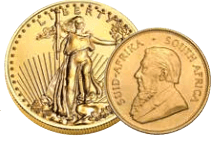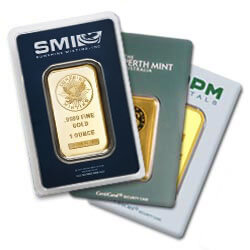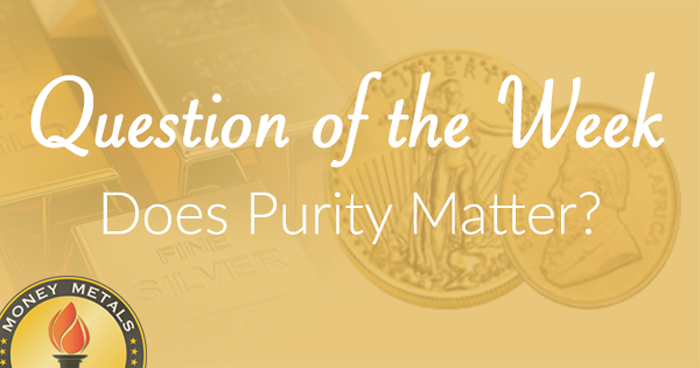dWhat You Need to Know When Investing in Different Types of Coins
Bullion investors often ask the question: Does purity matter? Well, sometimes yes, and sometimes no.
Let me explain.
First off, and generally speaking, of course, the only real factor that matters is the
melt value of the gold or silver product in question. For instance, while not all of the popular one-ounce gold bullion coins are created equal, they do all contain one full troy ounce of gold.
What is a Karat of Gold?
A karat is used to measure the purity of gold. 24 karats are pure gold and anything less, is the specified number with the remaining being another metal.

Gold Eagles and South African Krugerrands are alloyed
with other metals, but they still contain a full ounce of gold.
Both the gold coins from the US Mint like the Gold Eagle and South African Krugerrand are only 22 karat gold, and thus only contain 91.67% gold. But each coin still contains one full troy ounce of gold. In addition to the one troy ounce of gold, there is another metal alloyed (copper, and, in the case of the Eagle, some silver as well), which makes the overall weight of the Eagle and Krugerrand coins 1.091 troy ounces. The Eagle and the Krugerrand, widely considered the two most popular gold coins in one-ounce form in the world, are alloyed with copper to provide additional strength and durability.
In the case of the other popular one-ounce gold bullion coins – the Maple Leaf Canadian coinage, Australian Kangaroo gold coin, American Buffalo, and Austrian Philharmonic coin– there is no metal other than gold, meaning each is 24 karat (or .9999 pure) and each weighs exactly one troy ounce.
Bottom line, all of the above coins are of nearly identical value because the "melt value" of gold is the same – whether the purity is 22k or 24k.
Some of the older and historic coins – such as the gold coins before 1933 like U.S. Libertys and Indians and the popular coins from Europe like the British Sovereigns, Swiss and French 20 Francs, and others – contain 90% gold. These coins were circulating currency and therefore needed the extra durability and strength provided by a 10% copper alloy. But once again, the gold melt value is all that matters.
In silver, the dynamic is similar. For instance, the most popular retail silver bullion product where this purity question comes into play is junk silver – aka 90% or 40% U.S. silver coins. When buying junk silver, an investor simply gets the copper "for free" and thus pays only for the silver content. When it comes to pre-1965 90% silver dimes, quarters, and Kennedy half-dollar values, there are 0.715 ounces of silver for every $1 of face value (i.e. 10 dimes, 4 quarters, or 2 half dollars or any other combination that adds up to exactly $1). The 40% silver halves, minted from 1965 through 1970, contain just 0.295 ounces of silver for every $1 face value. Find out how to buy junk silver from Money Metals, by giving us a call! (Note: each of these silver melt values are industry standard figures for each dollar of coinage. They factor out the copper and factor in the metal loss from normal wear.)
Here's Where Purity DOES Matter...
There are few situations where purity does matter and must be considered.
When purchasing bullion specifically for a precious metals IRA, the IRS requires that the products meet a certain purity standard. As a general rule, non-pure gold, silver, platinum, and palladium bullion items will be prohibited for ownership inside a precious metals IRA.
However, there is one notable exception to this IRA purity rule, the American Gold Eagle. Even though the Eagle is only 22k (and therefore isn't .9999 pure), Congress granted it a special exemption since it is the flagship gold bullion product minted by the U.S. government.

Money Metals' .9999 pure gold bars are a popular
and low-cost way to invest in gold.
Another situation where purity is likely to be a factor is with 40% junk silver half dollars. This is a product you seldom see Money Metals Exchange promoting as a core investment because the sheer bulk of the 40% silver half dollars makes them less desirable for shipping and storage, as compared to other silver options. And they're generally less popular in the marketplace, which tends to increase the bid-ask spread on these coins.
For instance, a full bag of $1,000 face worth 40% half dollar contains only 295 ounces of silver but weighs approximately 50 pounds. Compare this to three 100-oz .999 pure silver bars where the weight is only slightly more than 20 pounds. So unless the 40% silver can be bought at a significant discount, we generally recommend investors look to other silver options.
Bottom line: know what you're getting, be aware of the melt value of gold or silver in the product you are considering, and try to keep your premiums above that melt value low.
In most cases, however, the purity of any mainstream retail bullion item doesn't make a whole lot of difference at the end of the day. In short, it's all about the ounces you own.
Note: Certain products are less marketable and harder to resell; therefore, we also recommend investors stay away from purchasing gold bars (of any size) with a purity of less than .9999 (that's four 9's) and silver bars or rounds that are less than .999 pure. Money Metals therefore only advertises .9999 pure gold bars and .999 pure silver bars.
Order Coins, Bars, or Rounds Online
or Call Us at 1-800-800-1865
This article was authored by Money Metals Director Mike Gleason.

About the Author:
Mike Gleason is a Director with Money Metals Exchange, a precious metals dealer named "Best Overall" by Investopedia. Gleason is a hard money advocate and a strong proponent of personal liberty, limited government, and the Austrian School of Economics. A graduate of the University of Florida, Gleason has extensive experience in management, sales, logistics, and precious metals investing. He also puts his longtime broadcasting background to use, hosting Money Metals' weekly precious metals podcast since 2011, a program listened to by tens of thousands each week.





